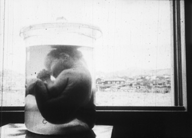The World Is Terrified: The Reality of the “Ash of Death”
(“Sekai wa kyofu suru: Shi no hai no shotai”) 1957 / B&W / 16mm (orig. 35mm) / 79 min
1957 / B&W / 16mm (orig. 35mm) / 79 min
Directors: Kamei Fumio, Teshigahara Hiroshi, Osanai Haruo
Photography: Kikuchi Shu, Fujii Yoshitaka, Usuda Junichi, Nishibori Michie
Editing: Shuzui Fusako
Sound: Ohashi Tetsuya, Okuyama Junosuke
Music: Nagasawa Katsutoshi
Narrator: Tokugawa Musei
Lighting: Kume Mitsuo, Aoki Toshio
Producers: Ono Tadashi, Inoue Takeo
Production Companies: Japan Document Film, Saneisha
Source: Japan Document Film
At a time when the USSR and the USA fervently vied to develop nuclear arms, the mass media buzzed with terms inspired by nuclear testing on Bikini Atoll such as the “Daigo Fukuryu Maru Incident,” the “ash of death,” “radioactive tuna,” and “radioactive rain,” and nuclear testing continued, Japan, the only nation to have suffered an atom-bomb attack, felt massive anxiety. “What is the radioactive ash of death?” “What effect does it have on living creatures?” Against the background of the era, the film scientifically describes the terrors of radioactivity with the cooperation of many scientists, physicians and research institutions. After the accident at the Chernobyl atomic power station in 1986, the film was thrown into the spotlight again. It enjoys a reputation as a superior science film and is still widely shown today. At the end of the film, Kamei’s words, ‘the “ash of death,” is a human creation, and so fundamentally different from natural disasters such as earthquakes and typhoons. Consequently, it stands to reason that it could be solved if only humanity were to demand this. I would like to record this here.’ The narrator is Tokugawa Musei, a famous movie orator (benshi) also remembered for Kobayashi Issa (1941). Foreign film distributor Saneisha distributed the film to theaters around the country and also aimed for a wide distribution internationally so that people around the world could see the film. Ogawa Shinsuke once praised it saying, “Kamei really surpasses himself in this amazing film.”
